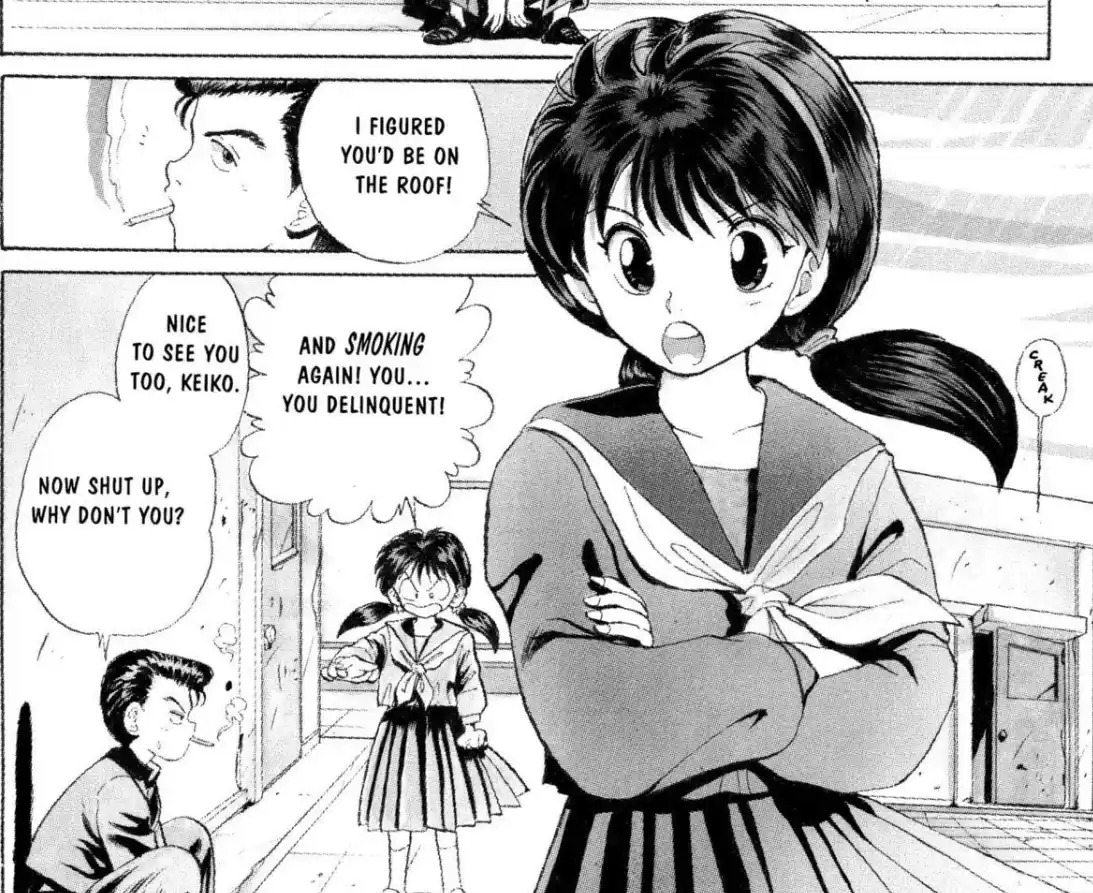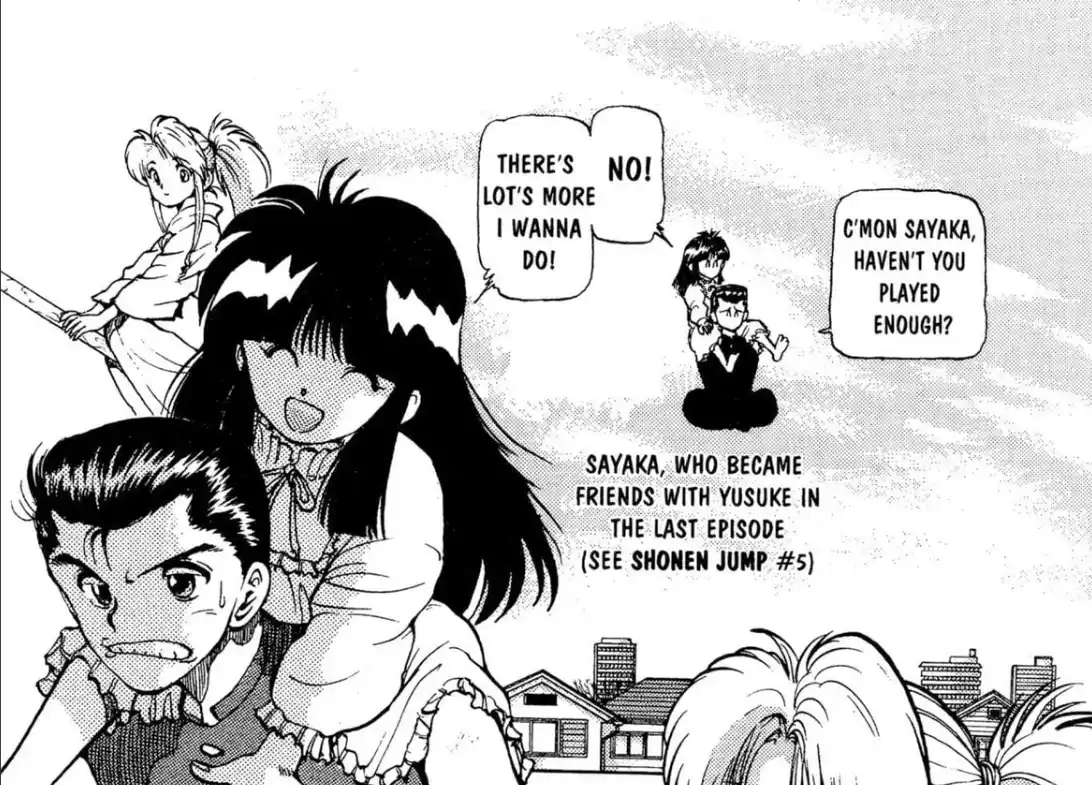☆ Rereading Yu Yu Hakusho - Spirit Detective Saga - Part 1 ☆
8/18/2024
My first exposure to Yoshihiro Togashi's Yu Yu Hakusho was its airing on Cartoon Network's Toonami block. The first episode gripped me like nothing ever had at that point. I saw a lot of myself in Yusuke Urameshi, though I was about half his age. Both my home and school lives were plagued with trouble, rebelliousness, and a general sense that I didn't want to be part of this kind of life. I certainly had never seen the main character of a show argue with his mother, pick fights, piss off teachers, and run away from home. Yusuke has a much harder edge than I did (for a few years), but I felt strangely represented for the first time.
And then he died, protecting someone he didn't even know.
By the time Kuwabara was storming into Yusuke's funeral, screaming and sobbing, I was enraptured. I may not have completely understood it at the time, but at this point I was forced to reflect on myself, my choices, and my behavior. Yusuke, by way of the impossibly cute Botan, gets a chance to do right in spirit form and, if he's lucky, get his body back.
Yu Yu Hakusho is a lot of things, for me. It's a story I personally connect with through its characters and world, something that genuinely left an impact on me. It's one of the premiere examples of what can be both so damned good and, so audaciously deflating in Shonen style battle manga.
I first read Yu Yu Hakusho, in entirety, in 2016. I got a sweet deal on pre-Amazon Comixology to get the complete series for under 40 dollars that previous Christmas. Score! The re-reading bug has bitten me, and so the manga, specifically, is what I'll be covering for this retrospective. While I won't be recapping every single scene of every chapter, it's gonna be the whole series. So, let's get started, shall we?
Humble Beginnings

While the most famous story arc in the series is the Dark Tournament, I don't think I would be alone in suggesting that YYH would simply not be what it is without its initial stories. The Spirit Detective arc, by chapters, is not much shorter, nor longer, than any of the others. Being the beginning of the series, it's naturally jam-packed with character introductions, development, and tone setting. It's also made up of smaller mini-arcs that give it a certain density. Looking at it as simply "before the Dark Tournament" would be a bit of a disservice to how much happens in its 50 chapters.
Yusuke is a textbook delinquent at the series opening, right out of Cromartie. But Togashi is able to quickly set up that Yusuke is not a hopeless bully. One of the best things about Yusuke is that while he does have a heart of gold, he isn't the type to take much shit, even on other people's behalf. These things are only in conflict sometimes because Yusuke's work as a spirit detective is just that, work. By framing Yusuke's tasks as assignments from Koenma and the Underworld, we can empathize with Yusuke being given something to do from his higher-ups, while at the same time rooting for him to succeed.
Yusuke's connection with love-interest Keiko Yukimura is another element that helps sell the early stories, and forms a strong emotional core. After his death, Yusuke has a brief chance to communicate with Keiko and explain his quest, before being locked out. It's sweet, and Keiko can even be seen as a deuteragonist before Yusuke gets his body back, with her and Kuwabara being the only accessible connections to the physical world.
The work that makes Yusuke a great character also applies to Kuwabara, Yusuke's rival that will turn ally, very soon. Being that they're so similar at a glance, Kuwabara's uniquities shine through. We frequently check in on Kuwabara and see what he's willing to do for those he cares about. He plays somewhat more dopey, and perhaps even honest compared to Yusuke, and it is so good. What you see is what you get with him, and it's awesome. It goes without saying that the funeral scene I linked above is one of the best in the whole series. When Kuwabara fully comes into the fold and learns about Yusuke in the spirit world, there's a sense of satisfaction that I admire. I'll have more to say about Kuwabara as we go, but for my money, he's one of the best characters in manga history.

The more one-off adventures at this time should be commended for carrying their own weight. My favorites include the girl friends bearing a curse, and the amusingly oomfie-coded Sayaka, who gets to stay around for a few chapters as an annoyance to Yusuke. She's funny, and she doesn't overstay her welcome either. I had wondered for a long time, was there some kind of original plan where this was the main premise behind Yu Yu Hakusho? Yusuke on various spirit quests every week?
A few times, even this early on and in such a brief, the rules of how returning to bodies, redemption, etc. change a bit on the fly. To an extent, and I say this with the utmost respect for the craft of manga, sometimes stuff is just made up. I think playing fast and loose with certain things is not the devil, or necessarily bad writing. To me, reading now especially, it seems symptomatic of a manga that was finding its footing and, possibly having editorial touch it. Did YYH transition into a fighting manga because this wasn't working? That's all entirely speculation and vibes from me, though, so what is the truth?
This interview with Togashi in Shonen Jump Exhibition, Vol 2**1 suggests that, effectively, the series was designed with a transition into a battle manga in mind. This blew my mind a bit to find out.
"Yu Yu Hakusho was supposed to be a battle manga, but there weren't any battles early in its run. Instead, there were good, heart-felt stories.
...
"My Supervisor was uncomfortable with me doing this, since it was my first battle manga. So instead, he asked me to start out with a 'good story', and eventually transition to battles from the 30th volume or so. I agreed to do this to get the green light."
- Yoshihiro Togashi, 2018
He goes on to compare YYH, to beloved classic, mega hit Kinnikuman, which seems quite apt! While I wouldn't say it's completely seamless, nailing this first transition with remarkable flare and good pacing is part of makes YYH fun to look at and study. It's definitely a gradual shift, and I would suggest that the manga makes another transition after the Dark Tournament. But for now, two dramatic introductions comes into play after Yusuke regains his body...
Kurama and Hiei

Two of these three characters are going to become enormously popular mainstays. Reading it now, it's hard to even imagine that either of them would ever be bit players. Their introduction is the exact point that the series begins featuring the one-on-one fights that it'll become famous for. In that same interview, Togashi notes that he imagined Kurama being popular, but never Hiei. I would say that Kurama's introduction is the most noteworthy in this group, but the order of events here is perfect.
Almost as if to welcome the new format, we first see Yusuke fight Gouki in an all out brawl, with an unsympathetic opponent who's a bigger, badder brute than Yusuke is. After the previous chapters, it's fun to see Yusuke be challenged in a way that he usually isn't, and it works well as a pace breaker of sorts. It's not the most clever fight in the universe, but it works.
Kurama's first story much more closely resembles what most of the series has been up until this point. I don't think that's an accident. It wouldn't surprise me if someone at Jump were worried about too drastic of a shift into fighting. Even the very last page feels like it could have come in any chapter before. That double page-view also nicely shows off what's so different about Kurama and Hiei at this early stage. When Kurama comes to save Yusuke, and casually shrugs off being stabbed, it feels like Yusuke's time spent being more kind and generous wasn't to waste. It's a nice wrap that makes things feel whole, even though they're changing.
Hiei has some other stuff going on, but a lot of it's not going to come into play until later. One thing I can't help but note is that it's absolutely, completely impossible for me to even look at Hiei and not hear Chuck Huber's excellent performance in the anime's English dub. In Japanese, Hiei is voiced by Nobuyuki Hiyama, a top favorite voice actor of mine. So, Hiei really rocks in the anime world!
For now, though, Hiei acts as the most ruthless and active villain that we've seen thus far. He's personally interested in killing Yusuke, and goes after Keiko himself. He's effective, and has a cool transformation (get used to seeing those!), but lacks an emotional core, for the time being. One thing about the Hiei battle is that you start to see how Togashi explores making dramatic reversals to end fights. I use the word explore, because the series is going to have a ton of these, and they don't all hit, for me. I have to imagine that this is one of the most challenging things about shonen action writing. If we go back to Kinnikuman again, it's filled with reversals (it's literally wrestling!!), weird powers, and secret techniques.**2 I don't envy anyone who has to come up with all these while having your characters be interesting and fun to watch. Still, nitpicking Yu Yu Hakusho just a bit is part of this retrospective.
1. This book, from what I can gather, is from an English version of promotional guidebook of sorts given out at this exhibition event in Japan. That's a lot of layers, and I've hit a brick wall trying to find out where this English translation actually came from. This seems to be the source of the information, but where did this English book come from?
2. I'm not a Kinnikuman expert, mind you. I watched Ultimate Muscle on TV as a kid, played a video game or two for a while, and have read a few scattered manga chapters. If any Kinnikuman fans want to grill me, that's fair! The panels I showed are from a fan scanlation of chapter 280. Your mileage may vary.
- James